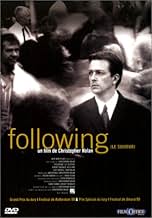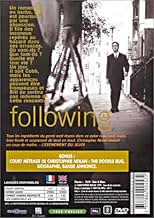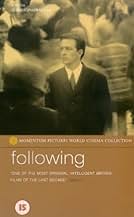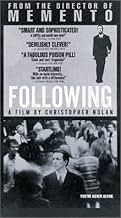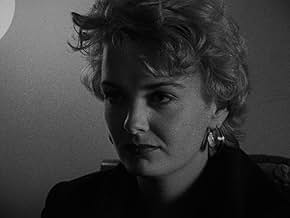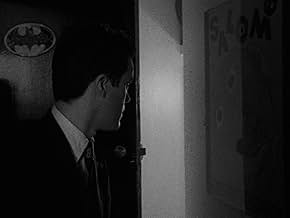A young writer who follows strangers for material meets a thief who takes him under his wing.A young writer who follows strangers for material meets a thief who takes him under his wing.A young writer who follows strangers for material meets a thief who takes him under his wing.
- Awards
- 5 wins & 4 nominations total
- Director
- Writer
- All cast & crew
- Production, box office & more at IMDbPro
Featured reviews
After watching Memento one might well wonder how Christopher Nolan pulled off something that audacious, that brilliant, in what was his major directorial debut. Watch Following, the no-budget thriller which was Nolan's actual directorial debut, and you begin to understand. With no money, with an amateur cast and doing pretty much everything (writing, shooting, directing) himself Nolan created a little masterpiece. Whatever "it" is that enables someone to make great movies Nolan clearly has it. And had it right from the beginning.
Fans of Memento will see a lot of similarities, hints of what was to come, in Following. The most obvious parallel is the nonlinear time structure as the story here unfolds completely out of order. Whereas the story in Memento proceeded more or less in a straight line which just happened to be moving backwards here there is no line at all. Scenes are placed in a seemingly random order. We're all over the place. At the end, in the beginning, somewhere in the middle, back to the end again...it really could have been a jumbled mess. But Nolan gives us a little assistance in orienting ourselves with the shifting appearance of his main character. He has three distinct looks to him and once you figure that out you can figure out where you are in the story. But there are still enough twists and turns to make your head spin, to keep you guessing right up to the end.
The less said about the plot the better. Best to let you try to piece the puzzle together for yourself. Much like Memento you really have to see it all the way through to fully appreciate the true genius of it, to understand how any missteps from Nolan along the way could have unraveled his whole story. When the movie concludes you can't help but be amazed that Nolan could pull this off essentially by himself. At least with Memento he had a little help. Here it's just Nolan and his small cast. There are really only three roles of any significance in the film, maybe four if you're being generous. But this little troupe and their first-time director combined to create something really special. The acting may at times seem a bit amateurish but that has to be expected from performers who are certainly not acting pros. And any little quibbles with the performances do not detract at all from the overall movie-watching experience. The actors do more than well enough to get by, well enough in fact that you're surprised there were not bigger acting roles for them somewhere down the line if they wanted them. That the performers have a great story to work with certainly helped their cause.
Things do get a little convoluted in the end as Nolan's story takes its final turns. You worry that things may be getting away from him a little bit. But he manages to ultimately pull it all together. You may have to really think about it after things are through but it all makes sense when you run it back in your mind. And it's nice every now and again to have a movie that actually requires you to think isn't it? Christopher Nolan seems to specialize in movies like that. He just makes great movies. Here he did it with no money, all on his own, never having made a movie before. It takes a special talent to pull that off. And among his many talents Nolan also apparently possesses the ability to see into his own future. When you watch Following note the Batman logo on the main character's apartment door.
Fans of Memento will see a lot of similarities, hints of what was to come, in Following. The most obvious parallel is the nonlinear time structure as the story here unfolds completely out of order. Whereas the story in Memento proceeded more or less in a straight line which just happened to be moving backwards here there is no line at all. Scenes are placed in a seemingly random order. We're all over the place. At the end, in the beginning, somewhere in the middle, back to the end again...it really could have been a jumbled mess. But Nolan gives us a little assistance in orienting ourselves with the shifting appearance of his main character. He has three distinct looks to him and once you figure that out you can figure out where you are in the story. But there are still enough twists and turns to make your head spin, to keep you guessing right up to the end.
The less said about the plot the better. Best to let you try to piece the puzzle together for yourself. Much like Memento you really have to see it all the way through to fully appreciate the true genius of it, to understand how any missteps from Nolan along the way could have unraveled his whole story. When the movie concludes you can't help but be amazed that Nolan could pull this off essentially by himself. At least with Memento he had a little help. Here it's just Nolan and his small cast. There are really only three roles of any significance in the film, maybe four if you're being generous. But this little troupe and their first-time director combined to create something really special. The acting may at times seem a bit amateurish but that has to be expected from performers who are certainly not acting pros. And any little quibbles with the performances do not detract at all from the overall movie-watching experience. The actors do more than well enough to get by, well enough in fact that you're surprised there were not bigger acting roles for them somewhere down the line if they wanted them. That the performers have a great story to work with certainly helped their cause.
Things do get a little convoluted in the end as Nolan's story takes its final turns. You worry that things may be getting away from him a little bit. But he manages to ultimately pull it all together. You may have to really think about it after things are through but it all makes sense when you run it back in your mind. And it's nice every now and again to have a movie that actually requires you to think isn't it? Christopher Nolan seems to specialize in movies like that. He just makes great movies. Here he did it with no money, all on his own, never having made a movie before. It takes a special talent to pull that off. And among his many talents Nolan also apparently possesses the ability to see into his own future. When you watch Following note the Batman logo on the main character's apartment door.
Saucy, eh ? If at all you're familiar with Christopher Nolan's style of film-making, watching this will at once make you realize where it all started. Its also of course possible that it began much before this but since much of that material isn't accessible to the public (save Doodlebug), we'll never really know. For all purposes, Following remains Nolan's feature film debut and it surely is a remarkable achievement.
The story follows Bill, a struggling unemployed writer who takes a liking to following people in hopes of finding material to write about. This liking soon turns into addiction forcing Bill to set rules to allow him to restrain his activities. One of the rules which he ends up breaking, is following the same person twice. The person with whom this rule is broken is Cobb, who soon confronts Bill about being followed. As it turns out, Cobb is a burglar who enjoys robbing people, not for the money, but rather for the sheer pleasure in taking away things that people took for granted; his belief being that it would make them realize what they had. Taken away by Cobb's lifestyle, Bill becomes a partner in his burglaries which is where the trouble begins.
Digging any more into the plot would serve to spoil the complex mystery that Following is. Following has a lot of those narrative structures that would become trademarks of Nolan's directorial style (intercuts, close-up inserts, non-linear editing, multiple chronologies, and so on). Nolan and crew were forced to make certain hard choices to obscure the severely limited budget, one of which was shooting the film in black and white. Of course, the plot was such that these decisions worked the film's favor. The film's incredible naturalism repeatedly comes to mind while watching the film. This is due largely in part to the film being shot hand-held, with scenes filmed in a take or two to save on film stock. The behind the scenes material with the film reveals this and other fascinating details about the film's production such as the crew shooting over weekends due to their jobs on weekdays as a result of which the film took a year to complete.
Despite the low budget, you're always hooked on to Following and that is due largely in part to the film's plot and tight writing (another of Nolan's strengths). Unlike many filmmakers who use lavish editing styles and gimmicky display effects, Nolan's films rely primarily on story and screenplay to get the viewers attention (with the occasional non-linear editing thrown in to really keep the audience alert at all times). Add to it, the intriguing characters which have personalities so distinct it appears Nolan himself followed a handful of people to get the traits right. Jeremy Theobald is as natural as the gullible Bill as Alex Haw is suave in the role of Cobb. And the chemistry between the two is so natural, it makes most of the dialogues they say seem improvised, as though real people were conversing.
Following is a great start for Nolan who has now moved on to bigger, elaborate and definitely better projects. It is a lesson for aspiring filmmakers that even with a limited budget, it is possible to make a feature as interesting, riveting and thrilling as some of the best noirs of the early 40s. While it may not be perfect, most of the limitations it suffers from are largely due to production values rather than plotting and pacing. It is nevertheless, a must watch for anyone who has even the slightest of respect for Christopher Nolan's film-making.
Overall Score: 7.0 / 10
The story follows Bill, a struggling unemployed writer who takes a liking to following people in hopes of finding material to write about. This liking soon turns into addiction forcing Bill to set rules to allow him to restrain his activities. One of the rules which he ends up breaking, is following the same person twice. The person with whom this rule is broken is Cobb, who soon confronts Bill about being followed. As it turns out, Cobb is a burglar who enjoys robbing people, not for the money, but rather for the sheer pleasure in taking away things that people took for granted; his belief being that it would make them realize what they had. Taken away by Cobb's lifestyle, Bill becomes a partner in his burglaries which is where the trouble begins.
Digging any more into the plot would serve to spoil the complex mystery that Following is. Following has a lot of those narrative structures that would become trademarks of Nolan's directorial style (intercuts, close-up inserts, non-linear editing, multiple chronologies, and so on). Nolan and crew were forced to make certain hard choices to obscure the severely limited budget, one of which was shooting the film in black and white. Of course, the plot was such that these decisions worked the film's favor. The film's incredible naturalism repeatedly comes to mind while watching the film. This is due largely in part to the film being shot hand-held, with scenes filmed in a take or two to save on film stock. The behind the scenes material with the film reveals this and other fascinating details about the film's production such as the crew shooting over weekends due to their jobs on weekdays as a result of which the film took a year to complete.
Despite the low budget, you're always hooked on to Following and that is due largely in part to the film's plot and tight writing (another of Nolan's strengths). Unlike many filmmakers who use lavish editing styles and gimmicky display effects, Nolan's films rely primarily on story and screenplay to get the viewers attention (with the occasional non-linear editing thrown in to really keep the audience alert at all times). Add to it, the intriguing characters which have personalities so distinct it appears Nolan himself followed a handful of people to get the traits right. Jeremy Theobald is as natural as the gullible Bill as Alex Haw is suave in the role of Cobb. And the chemistry between the two is so natural, it makes most of the dialogues they say seem improvised, as though real people were conversing.
Following is a great start for Nolan who has now moved on to bigger, elaborate and definitely better projects. It is a lesson for aspiring filmmakers that even with a limited budget, it is possible to make a feature as interesting, riveting and thrilling as some of the best noirs of the early 40s. While it may not be perfect, most of the limitations it suffers from are largely due to production values rather than plotting and pacing. It is nevertheless, a must watch for anyone who has even the slightest of respect for Christopher Nolan's film-making.
Overall Score: 7.0 / 10
Christopher Nolan's first feature film wowed critics who saw it when it first came out. Shot on a micro budget of $6,000 this is a student film with real class. The film is shot in black and white, and features people who you assume are friends of Nolan's appearing in the movie. This is not to say they are bad actors because they are quite good. You could see Jeremy Theobald and Alex Haw appearing in other projects but unfortunately they haven't since this was made 6 years ago.
Nolan's thriller, much like Memento, does not play chronologically, it shifts the scenes around much like Pulp Fiction. The writing is fantastic. It is a great twisting thriller but because the temporal order of the film is shifted around it makes it even more interesting. I thought the last ten minutes in particular when everything starts to become clear were excellent.
For a film of such a small budget and with no recognizable names at all, this is so good. It is superior to most that Hollywood studios offer and Nolan after three films (this, the superior Memento and the not quite as good but still excellent Insomnia) has cemented himself as the most exciting new talent of recent times. I can't wait for Batman.
This film is short and sweet and certainly a great watch. It is very professional and the twists are fantastic and completely surprising. I also thought that the score from David Julyan was also excellent, very atmospheric and had a chilly quality to it. He has gone on to compose Nolan's other films.
Overall I would recommend this, I intend to get all of Nolan's films. This is a low budget gem. *****
Nolan's thriller, much like Memento, does not play chronologically, it shifts the scenes around much like Pulp Fiction. The writing is fantastic. It is a great twisting thriller but because the temporal order of the film is shifted around it makes it even more interesting. I thought the last ten minutes in particular when everything starts to become clear were excellent.
For a film of such a small budget and with no recognizable names at all, this is so good. It is superior to most that Hollywood studios offer and Nolan after three films (this, the superior Memento and the not quite as good but still excellent Insomnia) has cemented himself as the most exciting new talent of recent times. I can't wait for Batman.
This film is short and sweet and certainly a great watch. It is very professional and the twists are fantastic and completely surprising. I also thought that the score from David Julyan was also excellent, very atmospheric and had a chilly quality to it. He has gone on to compose Nolan's other films.
Overall I would recommend this, I intend to get all of Nolan's films. This is a low budget gem. *****
The debut that plucked from obscurity one of the brighter stars of contemporary noir is an assured, if limited, stab at the con game and obsession. Filmed for zero money, Nolan couldn't have chosen a better subject than the drab and seamy underside of London to ply his trade, given the lack of funds. This short (67 min) is at its best in playing with the audience's and protagonist's expectations about who is scamming whom, though the initial set-up does ring some alarm bells in the credibility dept. The muddy cinematography (he often used natural lighting due to budget) can be mostly chalked up to noir stylization, though the limitations do show at times.
One can easily see Nolan's style developing in this fledgling effort; many of the same themes of blurred identity and expectation smashing recur in MEMENTO and INSOMNIA. Not a masterpiece but good and certainly worth a look for modern noir and Nolan fans.
One can easily see Nolan's style developing in this fledgling effort; many of the same themes of blurred identity and expectation smashing recur in MEMENTO and INSOMNIA. Not a masterpiece but good and certainly worth a look for modern noir and Nolan fans.
Great film. No gratuitous gimmicks like in most Hollywood films. Everything supported the suspense of the plot. B&w gave it a basic, no-frills feel also. In short, it was visceral in its simplicity of cinematography and cast.
Following serves as an interesting contrast to Memento. Characters in both used manipulation and subterfuge extensively. In that sense, both reminded me somewhat of "In the Company of Men," also highly recommendable. One difference between Nolan's two films is that Memento was a little easier for me to follow, given that the b&w scenes progress in a constant chronological direction, and so do those in color. I don't think that was true of Following, where scenes seemed to be shown at random. If you have the choice between VCR and DVD, I'd highly recommend DVD, since that gives you the option of watching the movie a second time in chronological order, not just in the scrambled (albeit ingenuous) order presented by Nolan. It also makes it easier, upon a second viewing, to piece the order together for yourself, if you want to.
As another viewer noted, one of the best things about both this movie and Memento is that none of the cast were famous. They were characters, not big-name actors who brought in personas developed in other movies.
Given certain similarities in the plots, I wonder if Memento is sort of a remake of Following, but intended to reach a bigger audience, like Edward Burns made She's the One in the mold of -- and with largely the same cast as -- The Brothers McMullan.
Following serves as an interesting contrast to Memento. Characters in both used manipulation and subterfuge extensively. In that sense, both reminded me somewhat of "In the Company of Men," also highly recommendable. One difference between Nolan's two films is that Memento was a little easier for me to follow, given that the b&w scenes progress in a constant chronological direction, and so do those in color. I don't think that was true of Following, where scenes seemed to be shown at random. If you have the choice between VCR and DVD, I'd highly recommend DVD, since that gives you the option of watching the movie a second time in chronological order, not just in the scrambled (albeit ingenuous) order presented by Nolan. It also makes it easier, upon a second viewing, to piece the order together for yourself, if you want to.
As another viewer noted, one of the best things about both this movie and Memento is that none of the cast were famous. They were characters, not big-name actors who brought in personas developed in other movies.
Given certain similarities in the plots, I wonder if Memento is sort of a remake of Following, but intended to reach a bigger audience, like Edward Burns made She's the One in the mold of -- and with largely the same cast as -- The Brothers McMullan.
Did you know
- TriviaSir Christopher Nolan never studied film-making at university. He studied English Literature at University College London, and used the film society there to shoot the opening dialogue scene between Bill and the policeman.
- GoofsIn one shot, when Cobb puts the gloves in the young man's mouth it is half sticking out but in the next scene it is almost completely in the young man's mouth.
- Crazy creditsThe movie was filmed from 1996 to 1997 and first released in 1998. However, the copyright date in the credits is listed as being 1999.
- Alternate versionsThe Criterion Collection DVD features an additional "Chronological Edit" of the film, which places the scenes in linear order.
- ConnectionsFeatured in Smashing UK Top 10: Top 10 Film Directors (2013)
- How long is Following?Powered by Alexa
Details
Box office
- Budget
- $6,000 (estimated)
- Gross US & Canada
- $48,482
- Gross worldwide
- $126,052
- Runtime
- 1h 9m(69 min)
- Color
- Sound mix
- Aspect ratio
- 1.37 : 1
Contribute to this page
Suggest an edit or add missing content


